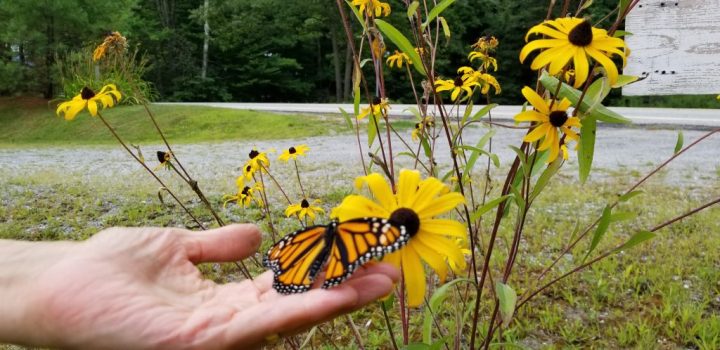This is an update to an earlier post (below, dated June 16) when I lamented the lack of monarch butterflies. The update is this: they are here.
The season started a little later, but Harriet found many eggs on our milkweed, gave them to her friends, and raised a number of monarchs herself. A good year, after all, at least in the world of monarchs.

Still eating milkweed 
Transforming in the chrysalis


FROM JUNE . . .
Last year at this time we were seeing butterflies all over our property. We had monarchs and swallowtails, more than we’ve had in years.
Harriet gave away forty monarch eggs she found on our milkweed plants, and she raised and released at least a half dozen monarchs of her own. She has fostered a network of butterfly-raising enthusiasts. They have a Slack channel.
This year: nothing. I haven’t seen one butterfly this season, not in my yard, not in all the acres of the Five Rivers Environmental Center, and I’m beginning to get a little concerned. Where are they? Is it just a pile-on during the age of covid-19?
Monarchs are a species in crisis, mostly due to industrial pesticide use in farming. The chemicals destroy milkweed, and monarchs will only lay their eggs on milkweed. That’s why every milkweed plant that springs up on our property is admired and counted. Some years we have more, some years less. Some years we see only a few monarchs–but we’ve never not seen any at all.

Monarchs are beautiful creatures and live fascinating lives, migrating between Mexico and the United States every year, requiring multiple generations in order to complete their journey. When you raise a monarch egg in a home habitat, you can witness the entire transformation of lifeform, from egg to caterpillar to chrysalis, to the emergence of the magnificent monarch.

And then you get to release the monarch into nature. What’s that like? Below is an excerpt from my novel, FLIGHT RISK, in which the main character, Robert, releases a monarch that his wife had raised.
Godspeed to you, butterfly. Good luck. May you live full and well the entire length of your potential 40-day lifespan. Although the sky had opened above it, and freedom beckoned, the monarch remained perched on its twig. For thirty seconds. For a full minute. Wings opening and closing, still testing. For another minute. And then—prompted by instinct or a stimulus-response mechanism, by whatever rudimentary or complex decision-making process motivates action—Sasha’s monarch (he considered it hers; Robert simply the doorman on duty), founded as an egg, fed and raised as a caterpillar, protected in its pupa stage, housed until it kicked free from the dark, tight chrysalis, transformed from the ugly duckling into the lovely swan—Sasha’s monarch did what butterflies do: it fluttered, rose and circled, zigged and zagged. It climbed in a spiral and vectored left over the garden, strafing the bee balm and the milkweed, flying over the forget-me-nots now forgotten with their delicate blooms shrunken and dried, gliding among the fruity orange and yellow day lilies, conducting a darting and dashing patrol of the entire garden, and finally soaring above the trees on an air current. Robert lost sight of the monarch through the gap in the tree canopy he created by felling the limb. He continued scanning the foliage and above the treetops and all around the yard. He wanted one more glimpse. Just one. He saw movement on the other side of the pool, but it was only a small white butterfly, an ordinary specimen. He was hoping the monarch would stay close, live in their yard, breed and raise a family, but of course this could not happen. Monarchs are driven by migratory instincts. There is no such thing as the domesticated butterfly.

